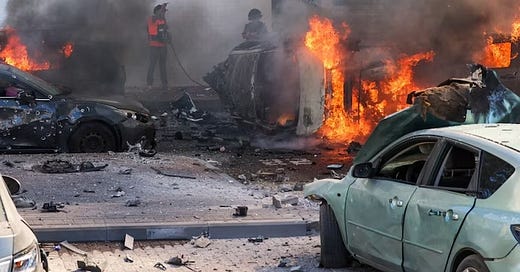Lately I’ve been rereading War and Peace.
The Frenchman was trying to say something, when suddenly a cannonball zoomed across viciously low over their heads, and the Frenchman ducked down so sharply he seemed almost to have been decapitated by it.
Pierre had ducked too, and let go of his man. With no further thoughts about who was capturing whom, the Frenchman rushed back inside the battery, and Pierre tore off downhill, tripping over the dead and wounded, who seemed to be catching at his feet.
But before he got to the bottom of the hill he ran into vast hordes of Russian soldiers falling over each other and whooping with glee as they charged up to storm the battery…
The French, who had taken the battery, now fled, pursued so far beyond the battery by our soldiers, yelling ‘Hurrah!’, that there was almost no stopping the Russians.
Prisoners were brought down from the battery, including a wounded French general, who was soon surrounded by our officers. Down came a stream of wounded men, some known to Pierre, some not, French and Russian, walking, crawling or carried on stretchers, their faces hideously contorted by pain.
Pierre went back up to the mound where he had spent more than an hour, and there was no one left from the little family group that had accepted him as one of their own. Dead bodies were everywhere, people he didn’t know. But one or two he did know. The little boy officer was still sitting there huddled against the earth wall in a pool of blood. The ruddy-faced soldier’s body was still twitching, but nobody picked him up.
Pierre ran back down the slope.
‘Oh, surely they’ll stop now. They’ll be horrified at what they’ve done!’ he thought, aimlessly following on behind crowds of stretchers away from the battlefield.
But the sun stood high in the sky, veiled by a pall of smoke, and ahead of them…the smoke was alive with movement, and the clamor of cannon and musket, far from dying away, was getting louder, in mounting desperation, like a man in terrible agony putting all his effort into one last scream.













I know Erik Hoel wrote about this recently with the rise of the "snuff clip" online, where images of war and violence pass around like our new global bloodsport, but I wonder how much images like this are shaping our response to atrocities. I can't help but think of the horror and visceral anger of Russia's invasion of Ukraine, an anger stoked by all the war footage shared freely on the world of Twitter, and how those images helped fuel the flames for a western policy that seems to have little care for its impact on the people in Ukraine itself as long as it hurts the Russians. And we are now seeing the terrorism of Hamas, the vicious images of violence toward those hostages and the reports of executions of even babies, likely leading to a brutal siege of the Gaza strip, one that is likely to decimate and displace its civilian population. Of course, it's worth adding that Hamas likely curated these images precisely to play to an audience looking for its own revenge against Israel, to fan their own flames of destruction.
Hell, my point doesn't need to stop at war. The recorded death of George Floyd, with its brutality laid bare for all to see, was followed by the most consequential and destruction riots in the modern history of the US, with the following rise in crime and loss of livelihoods still impacting people to this day. It's a modern kind of impact heuristic, real atrocities spread through images online followed by the inevitable righteous fury or glee (depending on who is destroyed) that calls for immediate action, no matter how destructive or unhelpful the consequences. And while there are political explanations I am glossing over, there's no avoiding that a picture or video can shape a policy.